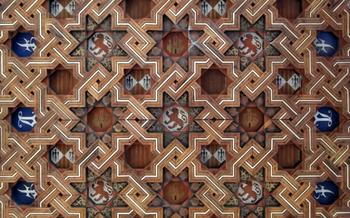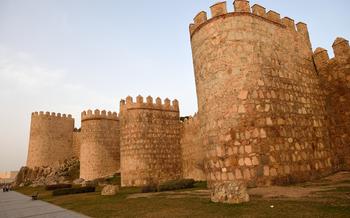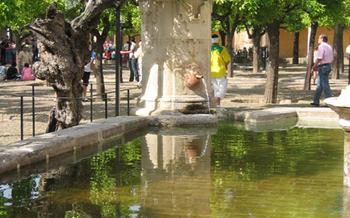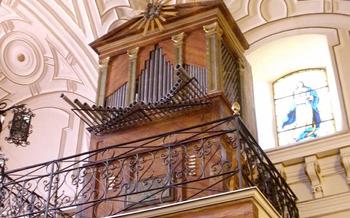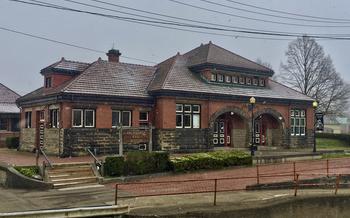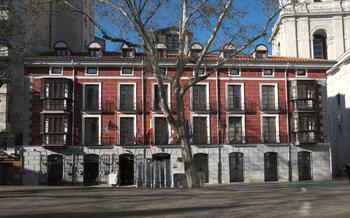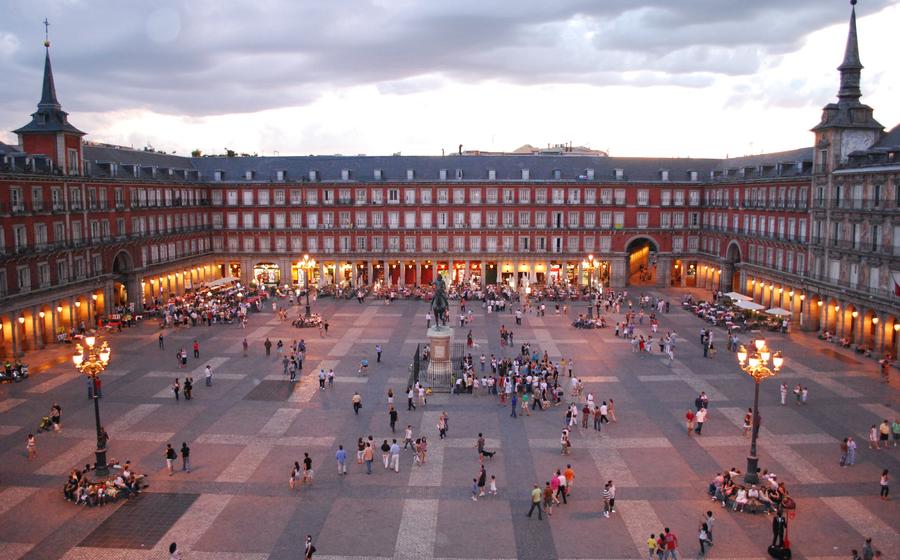
Avila (with its medieval city walls)
- Avila: A City Guarded by Time
- Exploring the Walls
- The Cathedral of Avila
- The Basilica of San Vicente: A Pilgrimage Site of Reverence
- The Monastery of Santo Tomas: A Royal Retreat
- The Jewish Quarter: A Hidden Gem in the Walled City
- The Plaza Mayor: The Heart of Avila's Social Life
- The Royal Monastery of Santa Ana
- The Museum of Avila
- The Park of the Four Posts
- The Walls Interpretation Center: Unveiling the History of Avila's Fortifications
- The Gastronomy of Avila
- Insider Tip:
Avila: A City Guarded by Time
The Antiquity of Avila:
Avila, a city nestled in the heart of Spain's Castile and León region, boasts a rich history dating back to the pre-Roman era. Its origins can be traced to the 11th century BC, when the indigenous Vettones tribe established a fortified settlement on a rocky outcrop, strategically positioned to control the surrounding plains. The city's strategic importance continued to grow, and by the 1st century AD, it had become a significant Roman municipium known as Abila. However, it was during the tumultuous Middle Ages that Avila truly rose to prominence. In the 11th century, King Alfonso VI of Castile reconquered the city from the Moors, initiating a period of rapid growth and prosperity. Recognizing the need to protect this strategic outpost, the city's fortifications were expanded and strengthened, giving rise to the imposing city walls that still stand today.
Exploring the Walls
To fully appreciate the grandeur of Avila's city walls, visitors should take the time to explore them from different perspectives. The best viewpoints to admire the walls are from the Four Posts Park, which offers panoramic views of the city and its surroundings, and from the viewpoint of the cathedral, which provides a unique perspective of the walls and the city's rooftops.
For a more immersive experience, visitors can walk along the top of the walls, which is open to the public. The walkway offers breathtaking views of the city and the surrounding countryside, and allows visitors to appreciate the intricate details of the walls, including the towers, gates, and battlements.
Guided tours and audio guides are available for those who want to learn more about the history and significance of the walls. These tours provide insights into the construction and defense of the walls, and highlight the important role they played in the city's past.
At night, the walls are illuminated, creating a magical atmosphere that enhances their beauty and grandeur. Visitors can take a leisurely stroll along the illuminated walls, enjoying the views of the city and the surrounding countryside.
The Cathedral of Avila
The Cathedral of Avila, also known as the Cathedral of Christ the Savior, stands as a testament to the city's rich history and religious significance. Constructed in the Romanesque style during the 12th and 13th centuries, the cathedral boasts an imposing Gothic interior that captivates visitors with its grandeur and intricate details.
Architectural Marvel: The cathedral's exterior facade showcases a harmonious blend of Romanesque and Gothic elements, featuring a grand rose window and intricate carvings that adorn its entrance. Inside, the nave boasts soaring ribbed vaults, supported by graceful columns that create a sense of awe-inspiring spaciousness.
Religious Significance: The Cathedral of Avila holds a deep religious significance for the city and the region. It is dedicated to Christ the Savior, and its construction was driven by the desire to create a grand edifice that would reflect the city's devotion and serve as a center of worship for the faithful.
Connection to the City Walls: The cathedral's strategic location atop the city walls highlights its close connection to the city's defenses. This positioning allowed the cathedral to act as a refuge and a lookout during times of conflict, further emphasizing its importance as a symbol of both religious and civic authority.
Spiritual and Cultural Heritage: Beyond its architectural splendor, the cathedral is home to a wealth of artistic treasures and religious relics. Visitors can admire the intricately carved choir stalls, the elaborate altarpiece, and the stunning stained-glass windows that illuminate the interior with colorful hues. These elements collectively contribute to the cathedral's status as a sacred space and a repository of Avila's spiritual and cultural heritage.
The Basilica of San Vicente: A Pilgrimage Site of Reverence
The Basilica of San Vicente, a majestic edifice in the heart of Avila, stands as a testament to the city's deep-rooted religious heritage. Erected between the 11th and 13th centuries, this Romanesque-Gothic masterpiece is not just an architectural marvel but also a significant pilgrimage site, drawing devotees from far and wide.
The basilica's fame revolves around the relics of Saint Vincent, a revered martyr who met his demise in 304 AD during the Diocletianic Persecution. Legend has it that the saint's body was miraculously transported by ravens to this very spot, where the basilica now proudly stands.
Pilgrims flock to the basilica to pay homage to Saint Vincent, seeking solace, divine intervention, and spiritual renewal. The basilica's interior exudes an aura of serenity, with its soaring arches, intricate carvings, and stained-glass windows casting a kaleidoscope of colors onto the hallowed ground.
Beyond its religious significance, the Basilica of San Vicente boasts an impressive collection of artistic treasures. The altarpiece, a masterpiece of Gothic art, depicts scenes from the life of Saint Vincent with exquisite detail and vibrant colors. The basilica also houses a museum showcasing sacred artifacts, religious paintings, and sculptures that narrate the story of Avila's rich Catholic heritage.
Whether you're a pilgrim seeking spiritual solace or an art enthusiast marveling at the basilica's artistic wonders, the Basilica of San Vicente promises an enriching and awe-inspiring experience that will linger in your memory long after your visit.
The Monastery of Santo Tomas: A Royal Retreat
Founded in 1482 by the Catholic Monarchs, Isabella I of Castile and Ferdinand II of Aragon, the Monastery of Santo Tomas stands as a testament to their deep faith and the city's rich history. This Dominican monastery, constructed in the Isabelline Gothic style, showcases a harmonious blend of architectural elements that reflect the transition from Gothic to Renaissance styles. The intricate carvings, delicate tracery, and elegant ornamentation that adorn the facade and interior create a sense of awe and wonder.
Within the monastery's walls, visitors can explore the serene cloisters, where the rhythmic arches and tranquil atmosphere invite contemplation. The highlight of the monastery is undoubtedly the church, with its soaring vaulted ceilings, intricate stained-glass windows, and elaborate altarpiece. The altarpiece, a masterpiece of Renaissance art, depicts scenes from the life of Saint Thomas Aquinas, the patron saint of the monastery.
Beyond its religious significance, the monastery also holds a unique place in Spanish history. It served as a royal residence for the Catholic Monarchs during their visits to Avila. Their presence left an indelible mark on the monastery, as evidenced by the royal coat of arms that adorns the facade and the ornate decorations that embellish the interior.
Today, the monastery houses the Museum of Oriental Art, a treasure trove of artifacts from around the world. Visitors can marvel at the exquisite collection of Chinese porcelain, Japanese lacquerware, Indian sculptures, and Southeast Asian textiles. The museum's collection provides a glimpse into the cultural exchanges and global connections that shaped Spain during the Age of Exploration.
The Jewish Quarter: A Hidden Gem in the Walled City
Within the confines of Avila's medieval walls lies a hidden gem—the Jewish quarter, a testament to the city's rich and diverse history. Once home to a thriving Jewish community, the quarter retains its unique character and charm.
Narrow, cobbled streets wind their way through the quarter, lined with well-preserved buildings that showcase a blend of architectural styles, from Gothic to Renaissance. The quarter's layout, with its intricate network of alleys and courtyards, reflects the traditional Jewish urban design.
The Jewish quarter of Avila holds great historical significance. It was established in the 12th century and became a prominent center of Jewish life and culture in Spain. The community flourished under the protection of the city's Christian rulers, who granted them certain privileges and autonomy.
The quarter's synagogues, once vibrant centers of worship and community gatherings, now stand as silent witnesses to the vibrant Jewish presence that once permeated these streets. The best-preserved synagogue, the Sinagoga Vieja, dates back to the 14th century and features intricate Mudejar-style decorations.
Despite the expulsion of the Jews from Spain in 1492, the Jewish quarter of Avila remains a poignant reminder of the city's multicultural past. The preservation of its unique architecture and heritage ensures that the legacy of the Jewish community continues to live on within the walls of this ancient city.
The Plaza Mayor: The Heart of Avila's Social Life
The Plaza Mayor stands as a testament to Avila's enduring grandeur, a masterpiece of Renaissance architecture that has served as the city's vibrant social and commercial hub for centuries. Built in the 16th century, this majestic square exudes an aura of timeless elegance, its arcaded walkways lined with charming shops, cafés, and restaurants, inviting visitors to soak in the city's vibrant ambiance.
The plaza's harmonious design, characterized by uniform arches and balconies adorned with intricate wrought-iron railings, creates a sense of unity and coherence. The surrounding buildings, with their distinctive pastel hues and ornate facades, further enhance the square's aesthetic appeal, making it a visual feast for the eyes.
As the sun dips below the horizon, the Plaza Mayor transforms into a magical realm, illuminated by soft golden light that casts a warm glow on its architectural wonders. The square comes alive with the sounds of laughter, music, and lively conversations, as locals and tourists alike gather to soak in the delightful atmosphere.
Whether you choose to savor a cup of coffee at one of the charming cafés, indulge in some retail therapy at the local shops, or simply bask in the beauty of your surroundings, the Plaza Mayor offers an unforgettable experience, a true representation of Avila's rich cultural heritage and vibrant spirit.
The Royal Monastery of Santa Ana
Founded in the 15th century by King Henry IV of Castile, the Royal Monastery of Santa Ana is a stunning example of Gothic architecture. Its construction was overseen by the Catholic Monarchs, Isabella I of Castile and Ferdinand II of Aragon, who were devoted to Saint Anne, the mother of the Virgin Mary. The monastery served as a royal residence and a place of worship for the monarchs and their court.
The monastery's architectural highlights include its elegant cloister, adorned with intricate carvings and arches. The church features a magnificent altarpiece, considered one of the finest examples of Gothic art in Spain. Visitors can also admire the beautifully preserved choir stalls and the impressive collection of religious artifacts housed within the monastery.
The Royal Monastery of Santa Ana played a significant role in the history of Avila. It was a center of religious and cultural life, and its royal connections brought prestige and influence to the city. Today, the monastery remains a cherished symbol of Avila's rich heritage, attracting visitors with its architectural beauty and historical significance.
The Museum of Avila
A Journey Through Avila's History and Art:
In the heart of Avila, nestled amidst medieval streets and historic landmarks, stands the Museum of Avila. A treasure trove of cultural and historical wonders, this museum invites visitors to delve into the rich tapestry of the city's past and its artistic heritage.
The museum's collection spans centuries, showcasing artifacts and artworks that tell the story of Avila's evolution from its ancient origins to its modern-day status as a UNESCO World Heritage Site. Ancient Roman relics, medieval manuscripts, and stunning Renaissance paintings adorn the museum's galleries, offering a glimpse into the city's diverse and storied history.
Highlights of the Museum:
-
Archaeological Treasures: Embark on a journey through time as you explore the museum's collection of archaeological artifacts, including prehistoric tools, Roman mosaics, and Visigothic jewelry. These relics offer a tangible connection to Avila's earliest inhabitants and their way of life.
-
Medieval Art: Step into the enchanting world of medieval art as you admire the museum's collection of sculptures, paintings, and religious objects. Intricate carvings, vibrant frescoes, and delicate goldsmith work showcase the exceptional craftsmanship and devotion of medieval artisans.
-
Renaissance Masterpieces: Marvel at the beauty and artistry of Renaissance paintings by renowned masters such as El Greco, Pedro Berruguete, and Juan de Borgoña. Their works, characterized by vibrant colors, realistic depictions, and religious symbolism, offer a glimpse into the artistic and spiritual climate of the Renaissance period.
-
Temporary Exhibitions: The museum regularly hosts temporary exhibitions that delve into specific aspects of Avila's history, art, and culture. These exhibitions often feature unique artifacts, historical documents, and contemporary works of art, providing visitors with a fresh perspective on the city's rich heritage.
The Museum of Avila is not just a repository of artifacts; it is a gateway to understanding the soul of the city. Through its diverse collection and engaging exhibits, the museum invites visitors to connect with Avila's past, appreciate its artistic legacy, and gain a deeper appreciation for its enduring cultural significance.
The Park of the Four Posts
The Park of the Four Posts, also known as the Prado de San Segundo, is a beautiful green space located just outside the historic center of Avila. It was created in the 19th century on the site of a former military parade ground and named after the four stone posts that marked the corners of the parade ground.
The park is a popular spot for locals and tourists alike to relax and enjoy the outdoors. It features a variety of trees and plants, including cedars, pines, oaks, and plane trees. There are also several fountains and sculptures scattered throughout the park, as well as a playground for children.
The Park of the Four Posts is also a great place to get a panoramic view of the city. From the park, you can see the city walls, the cathedral, and the mountains that surround Avila.
If you are looking for a place to relax and enjoy the outdoors, the Park of the Four Posts is a great option. It is a beautiful and peaceful place that offers something for everyone.
The Walls Interpretation Center: Unveiling the History of Avila's Fortifications
At the heart of Avila's historic center, nestled amidst the grandeur of its medieval walls, lies the Walls Interpretation Center, a treasure trove of knowledge dedicated to preserving and showcasing the city's rich history. Step into this captivating space, and embark on a journey through time, unraveling the stories behind Avila's iconic fortifications.
Interactive displays and multimedia presentations bring the city's past to life, immersing visitors in the struggles, triumphs, and transformations that shaped Avila's unique identity. Learn about the strategic importance of the walls, the architectural prowess of their construction, and the pivotal role they played in defending the city against countless sieges.
Through engaging exhibits, the center highlights the evolution of Avila's urban landscape, from its humble origins as a small Roman outpost to its rise as a thriving medieval city. Discover the significance of the walls in shaping the city's layout, influencing its architecture, and safeguarding its cultural heritage.
The Walls Interpretation Center is not just a repository of historical facts; it's a gateway to understanding the profound connection between Avila's past and present. By delving into the stories etched into the stones of the city walls, visitors gain a deeper appreciation for the resilience, determination, and artistry that have shaped Avila into the captivating destination it is today.
The Gastronomy of Avila
Avila's rich history and cultural heritage are reflected in its gastronomy, a fusion of traditional Castilian and Jewish influences. The city is renowned for its succulent roasted meats, particularly suckling pig and lamb, cooked in wood-fired ovens to achieve a tender and flavorful result. These dishes are often paired with local wines, such as the esteemed Ribera del Duero or Rueda varieties, enhancing the culinary experience.
Among the must-try local delicacies is the Judión de la Granja, a large white bean known for its buttery texture and nutty flavor. This bean is often cooked in a rich stew with chorizo, morcilla, and vegetables, creating a hearty and comforting dish.
For those with a sweet tooth, Yemas de Santa Teresa, delicate egg yolk pastries dusted with cinnamon, are a local specialty. These bite-sized treats are a tribute to the city's patron saint, Teresa of Avila, and offer a delightful burst of flavor.
To fully immerse oneself in Avila's culinary scene, one must venture into the city's vibrant tapas bars and restaurants. These establishments offer a wide array of traditional and contemporary dishes, allowing visitors to savor the diverse flavors and textures of Avila's cuisine.
Insider Tip:
-
To fully savor Avila's allure, plan your visit for the shoulder seasons (spring or fall) when the throngs of tourists have thinned, revealing the city's tranquil essence. Allow yourself at least two days to immerse yourself in Avila's historic tapestry.
-
Guided tours from Madrid provide a seamless and enriching way to explore Avila's treasures. These tours typically depart early, allowing ample time to delve into the city's iconic landmarks and hidden gems. Alternatively, for a more independent experience, rent a car and embark on a self-guided adventure, savoring the flexibility to explore at your own pace.
-
Extend your Spanish sojourn by combining your Avila visit with neighboring destinations that boast their own distinct charms. Segovia, with its awe-inspiring Roman aqueduct and majestic Alcázar, is a mere hour's drive away. Alternatively, venture to Toledo, a city steeped in history and renowned for its stunning Gothic architecture and El Greco masterpieces.
